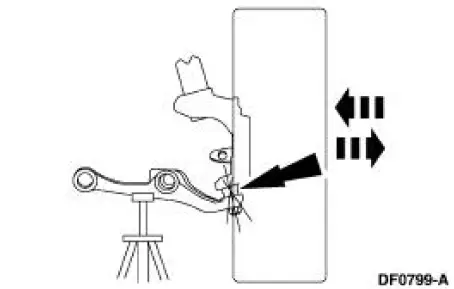Ford Mustang (1999-2004) Service Manual: Component Tests
Ball Joint Inspection
1. Raise and support the vehicle.
2. Prior to performing any inspection of the ball joints, inspect the wheel bearings.
3. Position a safety stand beneath the front suspension lower arm (3079) to be tested.

4. While an assistant pulls and pushes the bottom of the tire, observe the relative movement between the lower spindle arm and the front suspension lower arm ball joint. Any movement at or exceeding the specification indicates a worn or damaged lower ball joint. Install a new front suspension lower arm.
Wheel Bearing Inspection
1. Raise the vehicle until the tire is off the floor.
2. NOTE: Make sure the wheel rotates freely and the brake pads are retracted sufficiently to allow movement of the tire and wheel assembly.
Grasp each tire at the top and bottom and move the wheel inward and outward while lifting the weight of the tire off the wheel bearing.
3. If the tire and wheel (hub) is loose on the wheel spindle or does not rotate freely, install a new front wheel hub (1104) as necessary.
 Symptom Chart
Symptom Chart
Condition
Possible Sources
Action
Dogtracking
Excessive rear
thrust angle.
Front or rear
suspension
components.
Drive axle
damaged.
...
 Camber and Caster Adjustment - Front
Camber and Caster Adjustment - Front
All vehicles
1. Remove the rivet. Loosen the nuts and bolt.
Vehicles requiring camber adjustment
2. Move the front suspension camber adjusting plate (3B391) to the required
camber setting.
Vehicl ...
Other materials:
Cylinder Block Core Plug Replacement
Special Tool(s)
Slide Hammer
100-001 (T50T-100-A)
Material
1. Use a slide hammer or tools suitable to remove the cylinder block core
plug.
2. Inspect the cylinder block plug bore for any damage that would interfere
with the correct sealing ...
Disc and Pressure Plate - 4.6L (4V) Engine
Special Tool(s)
Clutch Aligner
308-020 (T74P-7137-K)
Material
Item
Specification
Premium Long Life Grease
XG-1-C
ESA-M1C75-B
1. Disconnect the battery ground cable. For additional information, refer to
Section.
2. Remove t ...
General Maintenance Information
NOTE: This is a generic maintenance schedule for all Ford, Lincoln and
Mercury vehicles. There may
be items listed that do not apply to all vehicles.
The Normal Schedule applies to operation of the vehicle under typical, everyday
driving conditions.
The ma ...
